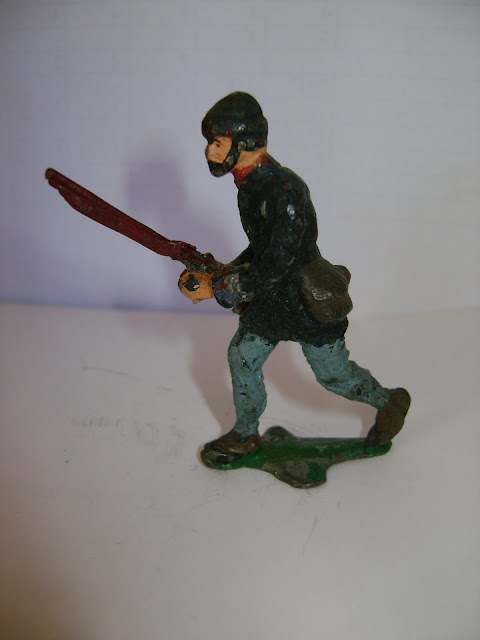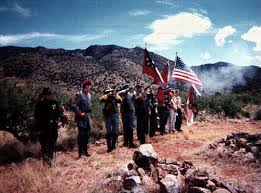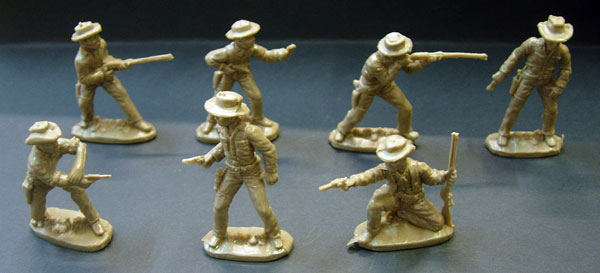 Available military forces were inadequate to cope with these foemen, and there were few men hardy enough and lucky enough to live in the region south of Tucson. Among these was Pete Kitchen(above), a Kentuckian who feared neither man nor the devil.
Available military forces were inadequate to cope with these foemen, and there were few men hardy enough and lucky enough to live in the region south of Tucson. Among these was Pete Kitchen(above), a Kentuckian who feared neither man nor the devil.  On his ranch called the Potrero, 14 miles south of Tumacacori, he built a hilltop fortress and ranchhouse, and while not fighting off Apaches, conducted a lucrative hog ranch, selling hogs in Tucson.
On his ranch called the Potrero, 14 miles south of Tumacacori, he built a hilltop fortress and ranchhouse, and while not fighting off Apaches, conducted a lucrative hog ranch, selling hogs in Tucson. Some() time before the arrival of the railroad on the border in the early 1880's, the city of Nogales was founded, by one Jacob Isaacson.
Some() time before the arrival of the railroad on the border in the early 1880's, the city of Nogales was founded, by one Jacob Isaacson.  He built a store at or near the site of the present Southern Pacific station. After railroad construction gangs arrived he apparently found the district too congested with people, and moved awaySituated on the Santa Cruz River just north of the Mexican border, this was the best known pioneer ranch in southern Arizona during the 1850's and 1860's. Replicants my collection
He built a store at or near the site of the present Southern Pacific station. After railroad construction gangs arrived he apparently found the district too congested with people, and moved awaySituated on the Santa Cruz River just north of the Mexican border, this was the best known pioneer ranch in southern Arizona during the 1850's and 1860's. Replicants my collection
Pete Kitchen, a newcomer to Arizona, established it in 1854. The ranchhouse, as much a fort as a home, became a rallying point and refuge for would-be settlers and travelers during the bloody Apache wars. Kitchen engaged in truck gardening and stockraising, especially hogs, and hired many Mexicans and Opata Indians. Growing rich as a supplier of forts and stores from El Paso to Yuma, he was especially noted for his hams and bacon, considered to be the finest in the Southwest..
 The original adobe building in which Kitchen lived until the 1880's is still intact. The present owner, Col. Gil Procter, has stabilized the walls and added a new roof. The more pretentious adobe ranchhouse that Kitchen later built is also still standing, and Procter uses it as a residence and museum. The museum is open to the public.
The original adobe building in which Kitchen lived until the 1880's is still intact. The present owner, Col. Gil Procter, has stabilized the walls and added a new roof. The more pretentious adobe ranchhouse that Kitchen later built is also still standing, and Procter uses it as a residence and museum. The museum is open to the public.
The railroad brought a steady trickle of settlers to the border region; after the surrender of the famous Geronimo in 1886 marked the official end of the Apache wars, the trickle became a stream. People began settling in the Tumacacori district, with the result that the church changed hands several times before the turn of the century.

After Mexico wrested control of the territory from Spain, and didn't have the resources (and/or possibly the will) to continue it, the practice was ended. It had worked for quite a number of years, but the various Chiricahua bands resumed traditional raiding to acquire what they needed after the Mexicans no longer made provisions for them (in the 1830s).

As a result, the Mexican government began a series of military operations in order to either capture or neutralize the Chiricahuas, but they were fought to a standstill by the Apaches.below pegaso As part of their attempts at controlling the Chiricahuas particularly, Mexican forces, often with the help of American and Native American mercenaries, began to kill Apache civilians, many times paying bounties for their scalps.below sonora
As part of their attempts at controlling the Chiricahuas particularly, Mexican forces, often with the help of American and Native American mercenaries, began to kill Apache civilians, many times paying bounties for their scalps.below sonora
 As part of their attempts at controlling the Chiricahuas particularly, Mexican forces, often with the help of American and Native American mercenaries, began to kill Apache civilians, many times paying bounties for their scalps.below sonora
As part of their attempts at controlling the Chiricahuas particularly, Mexican forces, often with the help of American and Native American mercenaries, began to kill Apache civilians, many times paying bounties for their scalps.below sonora
Cochise's father was one of these victims. This hardened Cochise's resolve and gave the Chiricahuas Apaches more rationale for vengeance. Mexican forces did capture Cochise at one point in 1848 during an Apache raid on Fronteras, Sonora, but they exchanged him for nearly a dozen Mexican prisoners

.The region inhabited by the Apache had experienced strife and tension between the Apache and European settlers beginning with Spanish occupation around 1600 until the greater part of the area was acquired by the United States in 1850,mexican soldier early 1800's which ushered in a brief period of relative peace. In the late 1850s, Cochise may have even supplied firewood for the Butterfield Overland Mail stagecoach station at Apache Pass. valcan ltd. Confedreates also fought the Apache in Arizona. See below
valcan ltd. Confedreates also fought the Apache in Arizona. See below
 valcan ltd. Confedreates also fought the Apache in Arizona. See below
valcan ltd. Confedreates also fought the Apache in Arizona. See below
The tenuous peace did not last as American encroachment into Apache territory continued, ending in 1861 with the Bascom Affair. An Apache raiding party had driven away a local rancher's cattle and kidnapped his twelve-year-old son (Felix Ward, who later became known as Mickey Free). Cochise and his band were falsely accused of the incident (which had actually been perpetrated by Coyotero Apaches). An unsuspecting Cochise was invited to the Army's encampment by an inexperienced Army officer (Lt. George Bascom), who assumed that Cochise was responsible.

Although the Apache leader truthfully maintained his innocence, and offered to look into the matter with other Apache groups, the young officer attempted to arrest him. Cochise jumped to his feet and immediately escaped by drawing a knife and slashing his way out of the tent. Cochise may have been shot as he fled.Bascom did succeed in capturing some of Cochise's relatives, who apparently were caught by surprise as Cochise escaped. Cochise eventually also took hostages to use in negotiations to free the other Indian hostages. However, the negotiations fell apart, mostly because of Bascom's 

intransigence, but also because the arrival of more U.S. troops made Cochise believe that the situation was spiraling out of his control. Both sides eventually killed all their remaining hostages, and the Apache leader went to Mexico while things cooled off. Cochise's brother and two of his nephews were among the hostages executed by Bascom, which served to further enrage the Apache leader and foment about 11 years of relentless warfare which left southern Arizona a mostly burned-out wasteland (in terms of white and Mexican civilization).  The death toll may have reached as many as 5,000 settlers and travelers (many historians believe this number is an extreme exaggeration, that the toll was more likely a few hundred). The treachery of Lt. Bascom is still remembered by the Chiricahuas' descendants today—they remember it as "Cut the Tent."When Texas seceded from the Union early in 1861, officials in Washington rewrote the Overland Mail contract so that the stages would travel through Nebraska and Utah rather than Texas, New Mexico and Arizona. Effective immediately, the Overland Mail abandoned the Southwest, terminating all operations along the southern route. This was a devastating blow to the settlers in the New Mexico Territory, which included present-day Arizona. The change was quickly obvious to the Apaches who surely watched from the mountains as the wagons, horses and mules were gathered up in an ever-growing caravan heading for California. The ominous parade included more than 200 horses, many mules, wagons, supplies, and twenty-one stagecoaches, empty except for the driver. The Overland Mail was moving out lock, stock, and barrel, and the Apaches found themselves unchallenged over the 300 miles of the stage route. They burned stage stations and destroyed coaches, but the worst effect was
The death toll may have reached as many as 5,000 settlers and travelers (many historians believe this number is an extreme exaggeration, that the toll was more likely a few hundred). The treachery of Lt. Bascom is still remembered by the Chiricahuas' descendants today—they remember it as "Cut the Tent."When Texas seceded from the Union early in 1861, officials in Washington rewrote the Overland Mail contract so that the stages would travel through Nebraska and Utah rather than Texas, New Mexico and Arizona. Effective immediately, the Overland Mail abandoned the Southwest, terminating all operations along the southern route. This was a devastating blow to the settlers in the New Mexico Territory, which included present-day Arizona. The change was quickly obvious to the Apaches who surely watched from the mountains as the wagons, horses and mules were gathered up in an ever-growing caravan heading for California. The ominous parade included more than 200 horses, many mules, wagons, supplies, and twenty-one stagecoaches, empty except for the driver. The Overland Mail was moving out lock, stock, and barrel, and the Apaches found themselves unchallenged over the 300 miles of the stage route. They burned stage stations and destroyed coaches, but the worst effect was the loss of countless lives among the pioneers who found themselves abandoned by the very government that had encouraged them to settle this brittle and unforgiving land. The federal government in Washington had done little to claim their loyalty; the settlers repeatedly sent delegates to Congress to plead their cause, but they were not even given a polite hearing.
the loss of countless lives among the pioneers who found themselves abandoned by the very government that had encouraged them to settle this brittle and unforgiving land. The federal government in Washington had done little to claim their loyalty; the settlers repeatedly sent delegates to Congress to plead their cause, but they were not even given a polite hearing.
"The smoke of burning wheat-fields could be seen up and down the Santa Cruz Valley, where the troops were in retreat, destroying everything before and behind them. The government of the United States abandoned the first settlers of Arizona to the merciless Apaches."Said a newspaper article.
According to an article in the Tucson Weekly Arizonian of August 10, 1861, "We are hemmed in on all sides by the unrelenting Apache. Since the withdrawal of the Overland Mail and the garrison troops the chances against life have reached the maximum height. Within six months nine-tenths of the whole male population have been killed off, and every ranch, farm and mine of the country have been abandoned in consequence." these britans were found in a toy shop in mestre . the geezer sold them to me for like 20 pence each saying they were of no interest anymore
these britans were found in a toy shop in mestre . the geezer sold them to me for like 20 pence each saying they were of no interest anymore
 The death toll may have reached as many as 5,000 settlers and travelers (many historians believe this number is an extreme exaggeration, that the toll was more likely a few hundred). The treachery of Lt. Bascom is still remembered by the Chiricahuas' descendants today—they remember it as "Cut the Tent."When Texas seceded from the Union early in 1861, officials in Washington rewrote the Overland Mail contract so that the stages would travel through Nebraska and Utah rather than Texas, New Mexico and Arizona. Effective immediately, the Overland Mail abandoned the Southwest, terminating all operations along the southern route. This was a devastating blow to the settlers in the New Mexico Territory, which included present-day Arizona. The change was quickly obvious to the Apaches who surely watched from the mountains as the wagons, horses and mules were gathered up in an ever-growing caravan heading for California. The ominous parade included more than 200 horses, many mules, wagons, supplies, and twenty-one stagecoaches, empty except for the driver. The Overland Mail was moving out lock, stock, and barrel, and the Apaches found themselves unchallenged over the 300 miles of the stage route. They burned stage stations and destroyed coaches, but the worst effect was
The death toll may have reached as many as 5,000 settlers and travelers (many historians believe this number is an extreme exaggeration, that the toll was more likely a few hundred). The treachery of Lt. Bascom is still remembered by the Chiricahuas' descendants today—they remember it as "Cut the Tent."When Texas seceded from the Union early in 1861, officials in Washington rewrote the Overland Mail contract so that the stages would travel through Nebraska and Utah rather than Texas, New Mexico and Arizona. Effective immediately, the Overland Mail abandoned the Southwest, terminating all operations along the southern route. This was a devastating blow to the settlers in the New Mexico Territory, which included present-day Arizona. The change was quickly obvious to the Apaches who surely watched from the mountains as the wagons, horses and mules were gathered up in an ever-growing caravan heading for California. The ominous parade included more than 200 horses, many mules, wagons, supplies, and twenty-one stagecoaches, empty except for the driver. The Overland Mail was moving out lock, stock, and barrel, and the Apaches found themselves unchallenged over the 300 miles of the stage route. They burned stage stations and destroyed coaches, but the worst effect was"The smoke of burning wheat-fields could be seen up and down the Santa Cruz Valley, where the troops were in retreat, destroying everything before and behind them. The government of the United States abandoned the first settlers of Arizona to the merciless Apaches."Said a newspaper article.
According to an article in the Tucson Weekly Arizonian of August 10, 1861, "We are hemmed in on all sides by the unrelenting Apache. Since the withdrawal of the Overland Mail and the garrison troops the chances against life have reached the maximum height. Within six months nine-tenths of the whole male population have been killed off, and every ranch, farm and mine of the country have been abandoned in consequence."
 these britans were found in a toy shop in mestre . the geezer sold them to me for like 20 pence each saying they were of no interest anymore
these britans were found in a toy shop in mestre . the geezer sold them to me for like 20 pence each saying they were of no interest anymore The Battle of Dragoon Springs was one of these engagements.
it was the unusual scenario of rebels fighting apaches, see later postDuring the raids, many people were killed on both sides, but the Apaches quite often had the upper hand, mostly because the United States was distracted by its own internal conflict—the looming Civil War, and did not have the resources in the area to deal with the Apaches from any position of strength. Additionally, the Apaches' were highly adapted to living and fighting in the hostile and unforgiving terrain of the southwest.
 It was many years before the Army, using tactics conceived by General Crookand later adopted by General Miles, were able to effectively challenge the Apache fighter on his own lands.t]Cochise joined with his father-in-law Mangas Coloradas (Red Sleeves, Kan-da-zis Tlishishen), the powerful Chihenne-Chiricahua chief, in a long series of retaliatory skirmishes and raids on the white settlements and ranches.
It was many years before the Army, using tactics conceived by General Crookand later adopted by General Miles, were able to effectively challenge the Apache fighter on his own lands.t]Cochise joined with his father-in-law Mangas Coloradas (Red Sleeves, Kan-da-zis Tlishishen), the powerful Chihenne-Chiricahua chief, in a long series of retaliatory skirmishes and raids on the white settlements and ranches.
it was the unusual scenario of rebels fighting apaches, see later postDuring the raids, many people were killed on both sides, but the Apaches quite often had the upper hand, mostly because the United States was distracted by its own internal conflict—the looming Civil War, and did not have the resources in the area to deal with the Apaches from any position of strength. Additionally, the Apaches' were highly adapted to living and fighting in the hostile and unforgiving terrain of the southwest.
 It was many years before the Army, using tactics conceived by General Crookand later adopted by General Miles, were able to effectively challenge the Apache fighter on his own lands.t]Cochise joined with his father-in-law Mangas Coloradas (Red Sleeves, Kan-da-zis Tlishishen), the powerful Chihenne-Chiricahua chief, in a long series of retaliatory skirmishes and raids on the white settlements and ranches.
It was many years before the Army, using tactics conceived by General Crookand later adopted by General Miles, were able to effectively challenge the Apache fighter on his own lands.t]Cochise joined with his father-in-law Mangas Coloradas (Red Sleeves, Kan-da-zis Tlishishen), the powerful Chihenne-Chiricahua chief, in a long series of retaliatory skirmishes and raids on the white settlements and ranches.
No comments:
Post a Comment